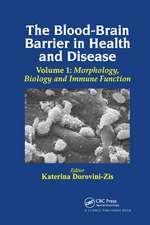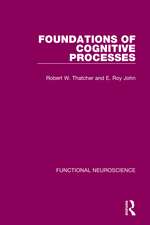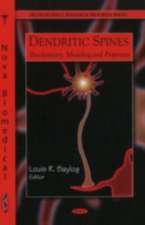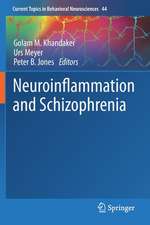Cerebrospinal Fluid and Subarachnoid Space: Volume 1: Clinical Anatomy and Physiology
Editat de R. Shane Tubbs, Joe Iwanaga, Elias B. Rizk, Anthony V. D'Antoni, Aaron S. Dumonten Limba Engleză Hardback – 13 oct 2022
- First comprehensive book devoted to clinical anatomy of cerebrospinal fluid and subarachnoid space
- Edited by neuro-anatomists and neurosurgeons, giving it a multimodal perspective
- Nerves and vessels color-coded to differentiate from other tissues
| Toate formatele și edițiile | Preț | Express |
|---|---|---|
| Hardback (2) | 1140.06 lei 5-7 săpt. | |
| ELSEVIER SCIENCE – 13 oct 2022 | 1140.06 lei 5-7 săpt. | |
| ELSEVIER SCIENCE – 13 oct 2022 | 1146.12 lei 5-7 săpt. |
Preț: 1140.06 lei
Preț vechi: 1485.11 lei
-23% Nou
Puncte Express: 1710
Preț estimativ în valută:
218.18€ • 226.94$ • 180.12£
218.18€ • 226.94$ • 180.12£
Carte tipărită la comandă
Livrare economică 07-21 aprilie
Preluare comenzi: 021 569.72.76
Specificații
ISBN-13: 9780128195093
ISBN-10: 0128195096
Pagini: 340
Ilustrații: 375 illustrations (375 in full color)
Dimensiuni: 191 x 235 mm
Editura: ELSEVIER SCIENCE
ISBN-10: 0128195096
Pagini: 340
Ilustrații: 375 illustrations (375 in full color)
Dimensiuni: 191 x 235 mm
Editura: ELSEVIER SCIENCE
Public țintă
Practitioners and researchers in neurology, neurosurgery and neuroanatomy Spine surgeons, anatomists, medical students, resident, fellows, nursesCuprins
1. Historical perspectives
2. Development of the ventricles, choroid plexus and subarachnoid space
3. Anatomy of the ventricles and subarachnoid spaces and cisterns
4. Anatomy of choroid plexus, capillary endothelial cells, ependymal layer, pia and arachnoid granulations/villi, extracellular space
5. Spinal punctures
6. CSF in the animal kingdom
7. Animal models for CSF testing
8. CSF physiology: Production, circulation, absorption, function, extrachoroidal formation/absorption
9. CSF and basal lymphatic system in mammals
10. A new look at CSF circulation
11. Virchow Robin spaces
12. CSF and disposition of alpha synuclein
13. CSF in pediatrics: prematurity, neonates, infants, and toddlers
14. CSF imaging
15. CSF in neurodegenerative disease processes
16. CSF in trauma
17. CSF in pregnancy
18. CSF in space, high-altitude or deep sea diving
19. CSF fluid replacement
20. Glymphatic system and CSF
21. Lymphatic system and CSF
22. Blood brain barrier
23. Intracranial/intraspinal pressure
24. Intracranial pressure (ICP) in trauma and autoregulation
25. ICP in slit ventricle syndrome
26. ICP and over drainage
27. Non invasive ICP monitoring
28. NPH
29. ICP in normal pressure hydrocephalus (NPH)
30. Neuropsychological testing and NPH
31. Shunt infections
32. Shunt complications
33. Drugs and CSF production and ICP
34. Hydrocephalus treatment “historical perspective
35. Hydrocephalus and shunt valves
36. Reasons for shunting and revision surgery: UK registry data
37. Infections of CSF
38. CSF and disease:
39. CSF and headaches
40. CSF markers and exosomes
41. CSF in Chiari I malformation
42. CSF in Chiari II malformation
43. Neurophysiological consequences of hydrocephalus
44. Hemorrhage and hydrocephalus
45. Arrested hydrocephalus
46. Aqueductal stenosis
47. Hydrocephalus and genetic disorders
48. Biomarkers of hydrocephalus
49. Long-term prognosis of fetal hydrocephalus
50. Circumventricular organs
51. Endoscopic third ventriculostomy and choroid plexus coagulation
52. Failure of ETV
53. Learning disabilities in hydrocephalus
54. Hydrocephalus in craniosynostosis
55. Syringomyelia
56. Arachnoid cysts
57. Neuro endoscopic anatomy
58. Endoscopy technique
59. Hydrocephalus in the developing world
60. Economics of hydrocephalus
61. Hydrocephalus and Fetal surgery for myelomeningocele
62. Ventricular anatomy in Chiari II malformation
63.Venous outflow obstruction and hydrocephalus
64. CSF markers before and after shunting
65. Spinal CSF compartments
66. Ventricular access devices in neonatal hemorrhage
67. Body position and lumbar CSF leak
68. Spontaneous CSF leak
69. Visual pathway and hydrocephalus
70. Effect of decompressive craniectomy on CSF pulsatility
71. Direct control of CSF pulsatility and its effect on cerebral blood Flow
72. The pulsating brain
73. Choroid plexus transport
74. Amyloid, tau, alpha synuclein and CSF dynamics
2. Development of the ventricles, choroid plexus and subarachnoid space
3. Anatomy of the ventricles and subarachnoid spaces and cisterns
4. Anatomy of choroid plexus, capillary endothelial cells, ependymal layer, pia and arachnoid granulations/villi, extracellular space
5. Spinal punctures
6. CSF in the animal kingdom
7. Animal models for CSF testing
8. CSF physiology: Production, circulation, absorption, function, extrachoroidal formation/absorption
9. CSF and basal lymphatic system in mammals
10. A new look at CSF circulation
11. Virchow Robin spaces
12. CSF and disposition of alpha synuclein
13. CSF in pediatrics: prematurity, neonates, infants, and toddlers
14. CSF imaging
15. CSF in neurodegenerative disease processes
16. CSF in trauma
17. CSF in pregnancy
18. CSF in space, high-altitude or deep sea diving
19. CSF fluid replacement
20. Glymphatic system and CSF
21. Lymphatic system and CSF
22. Blood brain barrier
23. Intracranial/intraspinal pressure
24. Intracranial pressure (ICP) in trauma and autoregulation
25. ICP in slit ventricle syndrome
26. ICP and over drainage
27. Non invasive ICP monitoring
28. NPH
29. ICP in normal pressure hydrocephalus (NPH)
30. Neuropsychological testing and NPH
31. Shunt infections
32. Shunt complications
33. Drugs and CSF production and ICP
34. Hydrocephalus treatment “historical perspective
35. Hydrocephalus and shunt valves
36. Reasons for shunting and revision surgery: UK registry data
37. Infections of CSF
38. CSF and disease:
39. CSF and headaches
40. CSF markers and exosomes
41. CSF in Chiari I malformation
42. CSF in Chiari II malformation
43. Neurophysiological consequences of hydrocephalus
44. Hemorrhage and hydrocephalus
45. Arrested hydrocephalus
46. Aqueductal stenosis
47. Hydrocephalus and genetic disorders
48. Biomarkers of hydrocephalus
49. Long-term prognosis of fetal hydrocephalus
50. Circumventricular organs
51. Endoscopic third ventriculostomy and choroid plexus coagulation
52. Failure of ETV
53. Learning disabilities in hydrocephalus
54. Hydrocephalus in craniosynostosis
55. Syringomyelia
56. Arachnoid cysts
57. Neuro endoscopic anatomy
58. Endoscopy technique
59. Hydrocephalus in the developing world
60. Economics of hydrocephalus
61. Hydrocephalus and Fetal surgery for myelomeningocele
62. Ventricular anatomy in Chiari II malformation
63.Venous outflow obstruction and hydrocephalus
64. CSF markers before and after shunting
65. Spinal CSF compartments
66. Ventricular access devices in neonatal hemorrhage
67. Body position and lumbar CSF leak
68. Spontaneous CSF leak
69. Visual pathway and hydrocephalus
70. Effect of decompressive craniectomy on CSF pulsatility
71. Direct control of CSF pulsatility and its effect on cerebral blood Flow
72. The pulsating brain
73. Choroid plexus transport
74. Amyloid, tau, alpha synuclein and CSF dynamics


























